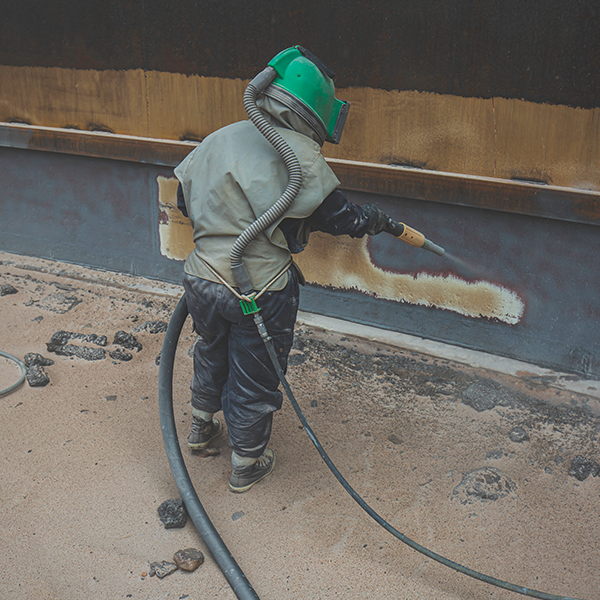
Sandblasting refers to using material compressed at high friction out of a hose to clean the layer of the metal surface. In this process, the material ejected by force strikes the surface and cleans it adequately. There are various sandblasting abrasives techniques that can effectively treat metal surfaces. For soft metals like aluminum and wood, it is recommended to use common materials such as walnut shells, corncobs, or pumice to achieve a clean and polished finish on the surface. But for more challenging jobs, materials like steel shots, glass beads, and aluminum oxide are used to give a clean and finished look.
A professional contractor specializing in sandblasting services in NJ will choose the right media for efficient results, as media selection is based on the desired results to proportionate the strength of the surface. So, let’s get to understand what are the various types of sandblasting techniques one can use to prepare the surface –
Soda Sand Blasting Technique –This method is frequently used for soft metals since it cleans them well without damaging the surface. It does not chemically react with metals and does not damage their protective covering. Compressed air is used to blast sodium bicarbonate particles against the surface, removing rust or corrosion from the metal without harming the surface's softer, more delicate layer.
Steel Grit Blasting Technique –Round steel balls are used as abrasives in this sandblasting method. Cleaning the outside of metals by this means is a common procedure. This technique is quite effective in removing the paint or rust from metal or other steel surfaces. Using steel grit also has an added advantage, like providing a smother surface finish and helping in penning, which helps strengthen the metal. This technique is generally used on any metal surface that needs a smooth finish and fast cutting removal.
Bead Blasting Technique –This technique uses air pressure-powered abrasive blasting methods along with glass beads. These glass beads are competent at cleaning, deburring, and penning metal surfaces. These glass beads are spherical and, when impacted on the metal surface, create a micro-dimple to administer a much more uniform finish to the metal surface. These glass beads are 100% recyclable, thus making this a cost-effective technique. In addition, using glass beads ensures that the abrasive is non-toxic and not harmful to the environment.
Reasons why to consider sandblasting technique –The sandblasting technique offers many benefits and can be used in wide applications. Below are some reasons why it is essential to consider the sandblasting technique for your next project –
Helps restore the rusty equipment –The sandblasting technique is perhaps one of the most efficient and convenient ways to remove rust and oil from the surface of the equipment. But, unfortunately, rust oxidizes the metals, thus causing damage to the equipment you use for various purposes in various commercial or industrial businesses.
So, whether you own a commercial or industrial business, having the surface of your equipment coated with a sandblasting technique is one of the easy and beneficial ways to make it look new. This is particularly beneficial if you are running a food business, and your equipment has accumulated rust and oil and needs to be transformed to its original look.
Helps remove contaminants –When manufacturing components, contaminants can enter and make it difficult to apply a coating and finish. Oil or grease is particularly problematic and can create an uneven finish or prevent surface treatment from sticking, even in small amounts. While some chemicals can remove these substances, it's a labor-intensive and potentially hazardous process. Sandblasting provides a safer and more efficient alternative.
Non-hazardous –While most surface cleaning preparations include the usage of harsh chemicals, acids, and various other toxic substances that are hazardous to breathe and may cause skin irritation but the sandblasting technique is free of such toxins and uses completely nontoxic abrasives that are safe for your equipment and the environment.
Helps prepare the surface for painting –In addition to removing the paint, rust, oil, grease, and contaminants from the surface of the metal, and other materials, the process of sandblasting creates a surface that is adapted and ready to accept a new finish or coating of the paint.
Moreover, the sandblasting technique can help remove the material's thin outer layer on a surface, thus leaving a smooth, bare surface primed for applications. This means your surface will readily accept any paint, finishes, or coatings you use after the sandblasting technique.
So, if your surface prep needs aren’t satisfactorily met by traditional methods. Consider employing the sandblasting technique, as this technique can help remove a range of contaminants and debris from surfaces and is safe for employees and the environment and cost-effective.
If you are searching for a renowned contractor for sandblasting services in NJ, look no further than NJ Reliable Coatings LLC. For more information on sandblasting surface prep, contact their experienced sandblasting professional at (908) 315-4723. Being one of the renowned sandblasting contractors in New Jersey, they can help various commercial or industrial businesses remove a range of contaminants and debris from metal surfaces to provide a clean and finished look to the equipment.